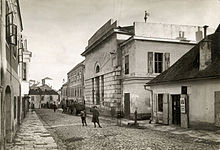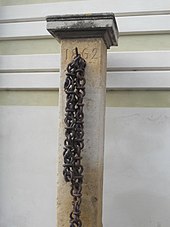Unterberg-Eisenstadt
Unterberg-Eisenstadt formed an independent municipality since 1732, which included the former Jewish quarter of today's municipality Eisenstadt , the capital of the federal state of Burgenland in Austria .
history
The respective judge was confirmed by the landlord and received the judge's staff from him as a sign of his dignity. In 1843 the community of Unterberg-Eisenstadt had the highest number of inhabitants with 876 Jews .
After the dependency on the Esterházy family ended in 1848, the Jews became free citizens with equal rights. In 1871 they founded the "Israelite Community of Eisenstadt", the independent "Grossgemeinde Unterberg-Eisenstadt" with its own mayor and bailiff. When Jews were allowed to settle in other cities in the second half of the 19th century, many gradually emigrated from Eisenstadt.
After the so-called " Anschluss " of Austria to the German Reich , Unterberg-Eisenstadt was incorporated into the free city of Eisenstadt in August 1938 .
Unterberg-Eisenstadt today forms a cadastral community of Eisenstadt.
Ghetto pillars
The column with the chain with which the Jews cordoned off Unterberg-Eisenstadt on Shabbat is a visible sign of political autonomy.
See also
literature
- Klaus-Dieter Alicke: Lexicon of the Jewish communities in the German-speaking area. Volume 1: Aach - Groß-Bieberau. Gütersloher Verlagshaus, Gütersloh 2008, ISBN 978-3-579-08077-2 ( online edition ).
Web links
Coordinates: 47 ° 50 ′ 46.3 " N , 16 ° 30 ′ 59.4" E




